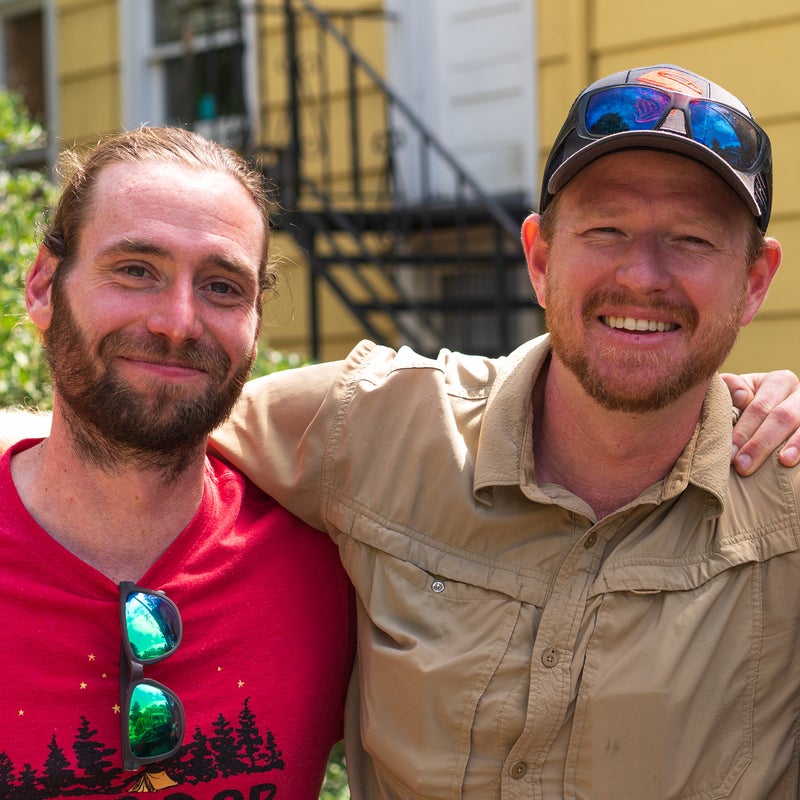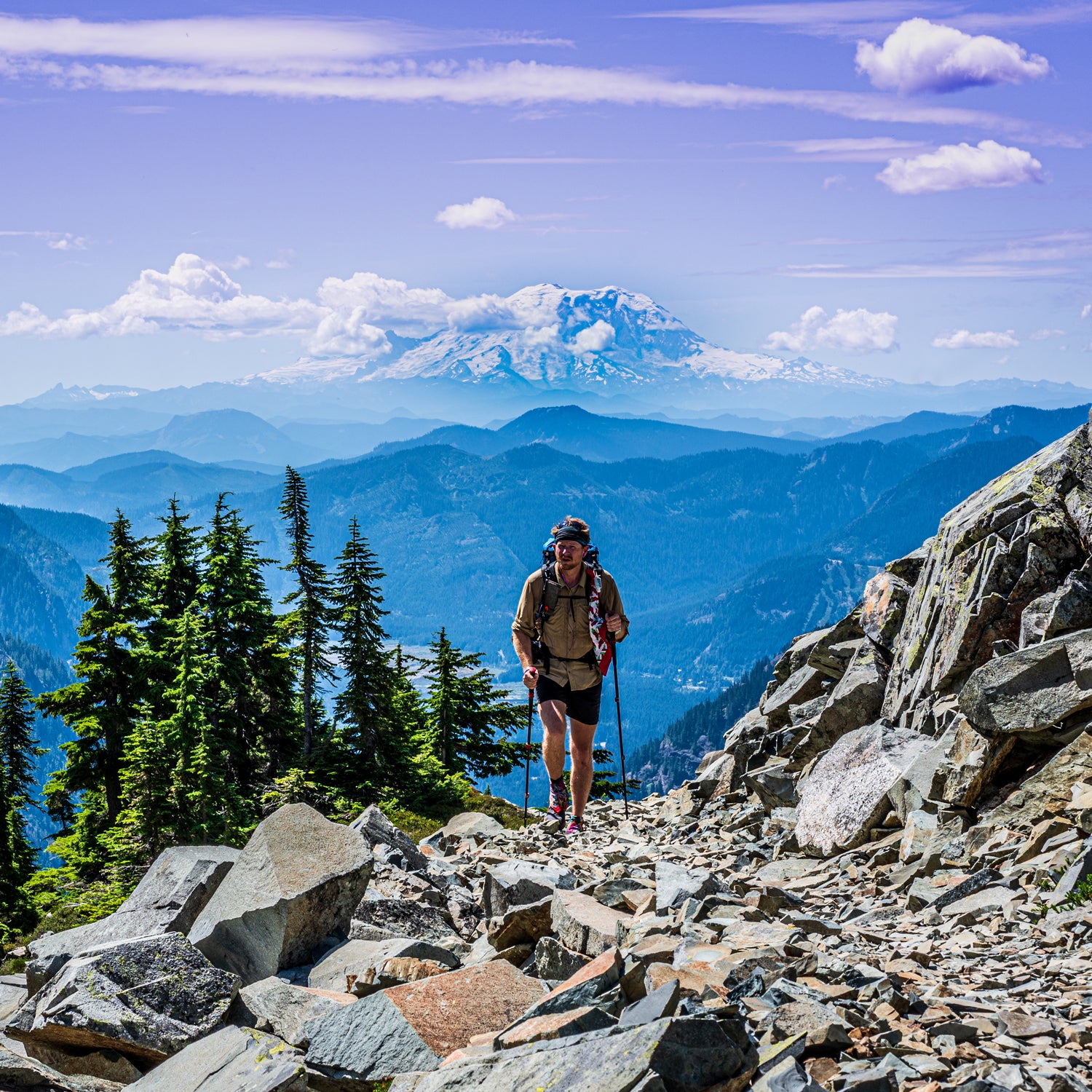While doing a routine check of passing vehicles in Muqdadiyah, Iraq, in 2006, Sergeant Trey Cate and his fellow soldiers were ambushed. Standing in the street, the initial blastÔÇötriggered by a suicide bomberÔÇöshattered his legs. Moments later, gunmen hidden on nearby rooftops opened fire, shooting him in the back, arm, and helmet. A stray bullet hit a barrel of gasoline, and fire enveloped the wounded soldiers, including Cate.
Remarkably, every soldier made it out alive. But when Cate got to the hospital, a doctor told him heÔÇÖd never walk again.╠řCate didnÔÇÖt accept it. ÔÇťWatch me prove you wrong,ÔÇŁ╠řhe told the doctor.
ÔÇťThey told me I didnÔÇÖt understand how injured I was,ÔÇŁ says Cate. ÔÇťI told them they donÔÇÖt understand my mentality.ÔÇŁ
Thirteen years later, not only does Cate, 35,╠řwalk, but he hiked the entire Appalachian Trail in 2017 and the Pacific Crest Trail in 2018.
Cate╠řwas introduced to former Marine Jeremy ÔÇťMacÔÇŁ McDonald, 34, as part of the thru-hiking community. Together,╠řthe two veterans are organizing one of the most ambitious thru-hiking expeditions in recent years: a ╠řthat will take╠řon the 6,875-mile Great Western Loop.╠ř
McDonald╠řspent eight years in the Marine Corps, did three tours in Iraq, and was the head of Marine security at the U.S. embassy in Dakar, Senegal. ÔÇťIÔÇÖve backpacked in some of the craziest places, just because IÔÇÖve gotten to travel so much,ÔÇŁ he says. In 2014, after he╠řleft the Marines, McDonald hiked the Appalachian Trail.
But Cate has the more unusual thru-hiking conversion story. Stuck in the hospital╠řas he recovered from his war injuries, Cate would spend hours daydreaming. ÔÇťIÔÇÖm in a hospital bed, and people are telling me IÔÇÖll never walk again, and so all I could think about was walking again,ÔÇŁ he says. Not accepting heÔÇÖd spend his life in a wheelchair, Cate forced himself to get out of bed and practiced putting one foot in front of the other.
ÔÇťWhile walking around, the hospital aides would follow me with a couch on wheels for when IÔÇÖd fall,ÔÇŁ Cate says. ÔÇťIÔÇÖd lost a lot of weight at this pointÔÇöIÔÇÖm six foot three,╠řand I weighed 140 pounds.ÔÇŁ
It was CateÔÇÖs younger brother who first told him about the Appalachian Trail. When Cate saw photos of how happy his brother looked while trekking╠řa 30-mile section, he immediately knew he wanted to thru-hike the entire thing. ÔÇťI had already been daydreaming about doing something with my legs,ÔÇŁ says Cate. ÔÇťWhy learn to walk again if I donÔÇÖt do something incredible?ÔÇŁ
But it wasnÔÇÖt only╠řthe injuries to his legs that Cate was trying to overcome. The blast left him with a traumatic brain injury, and when he initially came to in the hospital, he had amnesia. ÔÇťWhen I woke up, a woman was hugging me, and I thought, Wow, my girlfriend is old,ÔÇŁ says Cate. ÔÇťI shoved her away. But turns out╠řit was my mom.ÔÇŁ He recognized her after a few days, but his memories never fully returned.
After Cate retired from the Army and graduated from the University of South Florida in 2015, he decided to fulfill the promise heÔÇÖd made to himself on the hospital bed years ago. He began preparing to thru-hike the Appalachian Trail, but Cate╠řsays a side effect of his brain injury was that it left him overly trusting of others. On White Blaze, a forum for Appalachian Trail hikers, an anonymous user played a joke on him, feeding him false information about what thru-hiking entailed. He told Cate that if he started hiking the Appalachian Trail in January, he wouldnÔÇÖt need anything warmer than a 30-degree sleeping bag. (That is very incorrect; temperatures frequently drop╠řto single digits.) Cate also believed it when the stranger told him that the backcountry shelters had electric outlets, and that he could charge his phone there at night. (Also not true.)
Cate completed half of the hike, starting in Georgia and getting off trail at Harpers Ferry in West Virginia╠řbecause he wasnÔÇÖt appropriately prepared. He then went home, studied what he did wrong, and tried again the next year. That time╠řhe successfully hiked the entire trail, and he loved it.

The two got the idea to tackle the Great Western Loop because they wanted to do more with their passion for the outdoors, ÔÇťsomething really interesting that gets the attention of the entire thru-hiking community,ÔÇŁ says╠řCate. Taking a dozen people on the longest thru-hike in the United States╠řcertainly qualifies.╠ř
The loop╠řlinks together five existing long-distance trails: the Pacific Crest Trail, the Continental Divide Trail, the , the Arizona Trail, and the Pacific Northwest Trail. Its╠řfootpath follows the Sierra, the Cascades, and the Rocky Mountains╠řand passes through 12 national parks and 75 wilderness areas. To date, only two people have ever hiked the Great Western Loop to completion in a calendar year, one of whom is╠ř║┌┴¤│ď╣¤═° columnist╠řAndrew Skurka.
To accomplish their goal, Cate and McDonald╠řset up the expedition as an LLC called ╠řand partnered with a marketing company for publicity and to acquire sponsors to provide supplies and funds to the hikers, which include╠řMcDonald.╠řThey spent much of the last year getting╠řsponsors╠řand now have a budget of around $250,000. With the plan in place, they are ready to start hiking in March, beginning and ending in Cuba, New Mexico.
Because of the logistics required, Cate volunteered to follow the hikers in a support van rather than hike himself. ÔÇťThis level of organization is what we used for military missions,ÔÇŁ Cate says. ÔÇťYou have to consider everything down to the final detail:╠řthe weather, the supplies, the travel.ÔÇŁ Two vehicles will follow the hikers, ferry them to town, and resupply them with food. Support staff will also assess pick-up points, respond to emergencies,╠řand╠řeven do their laundry.╠ř
ÔÇťThere definitely will be a rate of injury,ÔÇŁ says Phaneendra Kollipara, one of the thru-hikers selected for the expedition. Kollipara, a 27-year-old engineer from India living in Michigan, has hiked all three major trails in the U.S. ÔÇťThere are things we can do to help prevent injury, but bad luck can happen to anybody,ÔÇŁ he╠řsays.
╠řbetween the ages of 22 and 36 and╠řhailing from four countries were selected. All are experienced thru-hikers. Each selected a charity to raise money╠řfor, including the , the , and the , and theyÔÇÖll be seeking╠řdonations while they hike as well as asking sponsors to support their chosen organizations.╠ř
Cate and McDonald initially spread word of their plans in person and by posting in thru-hiking Facebook groups, and soon enough, applications began flooding in. Experience in long-distance hiking was requisite,╠řbut not enough: Cate searched for individuals╠řwho were patient and╠řeasy to get along with and who╠řfollowed directions well. ÔÇťI tried to stay away from people who wanted to ÔÇśraceÔÇÖ the whole time╠řor would get angry the moment something didnÔÇÖt go their way,ÔÇŁ Cate says. They wanted people from different backgrounds, they recruited internationally, and they tried to balance the number of men and women. Because 12╠řpeople is an unwieldy number on a trail where campsites rarely fit more than four tents, the team╠řwill be divided into four groups of three people, with╠řstaggered╠řstart times.
Skurka was the first person to ever hike the Great Western Loop, completing it in 206 days in 2007. ÔÇťIt was complicated enough when I did it by my lonesome,ÔÇŁ he says. ÔÇťI canÔÇÖt imagine what it would take to organize for 12╠řpeople.ÔÇŁ
He╠řpoints out that the biggest challenge the group will face will be hiking through the Sierra Nevada╠řonce the snow starts to melt around mid-May, and then booking it all the way to the Rockies, where itÔÇÖll╠řhave to exit the San Juans of southern Colorado before the snow falls in October. ÔÇťYouÔÇÖre basically racing against winter the whole time,ÔÇŁ says Skurka. ÔÇťYou need to throw down 30 or 40 miles a day. ThatÔÇÖs the inherent difficulty.ÔÇŁ
Even if you can handle the physical challenge, says Skurka, it can be just as tough psychologically.
ÔÇťI would struggle to do that trip nowadays, because itÔÇÖs got so many mind-bogglingly boring miles, hour after hour after hour,ÔÇŁ he says. ÔÇťYou canÔÇÖt do these things for fame and fortune, you have to love it at the end of the day. There are too many hours at some level of discomfort to make it worthwhile otherwise.ÔÇŁ That said, Skurka looks back on the Great Western Loop as one of the best things heÔÇÖs ever done. ÔÇťI hope they can experience that, too.ÔÇŁ
Cate and McDonald are hopeful that the success of this╠řexpedition will╠řallow them to host new outdoor challenges in the future.╠řBut for now, theyÔÇÖre counting the days until the╠řadventure begins.
ÔÇťI am very excited,ÔÇŁ says McDonald. ÔÇťI wish we were starting yesterday.ÔÇŁ


